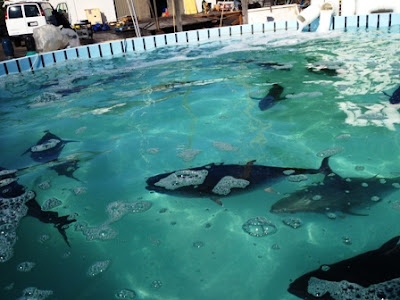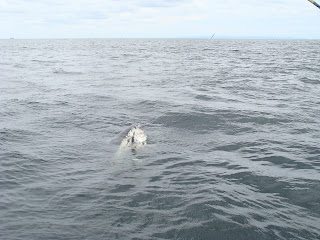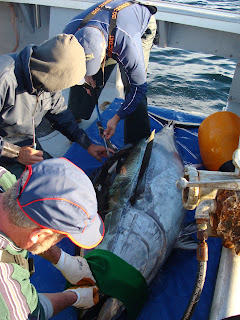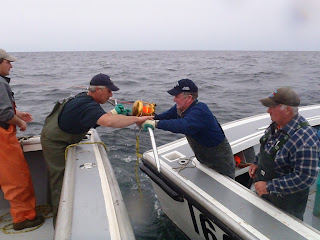Animal Athletes Train
for Research Season
Triple
respirometry experiments with our animal athletes at the TRCC
Tuesday the 5th of
December, 2012 saw three simultaneous respirometry experiments at the Tuna
Research and Conservation Center. One
78cm Pacific bluefin swam well in the large flume for 6 hours, and two 30cm
long Pacific Mackerel cruised along in the smaller flumes on a 48 hour
run. It was this tuna’s second time
training to swim in the flume, but it handled the challenge like a seasoned
champ, swimming perfectly in the center of the tank for the entire training
period. This performance earned him the
nickname “Rocky”, after Sylvester Stalone’s award-winning role as a
hard-training heavyweight boxing champion.
Indeed, the team has trained three other champion tunas this month, with
nicknames like George Foreman, Oscar de la Hoya, and Mike Tyson.
These champs have been stepping
into the respirometry ring day after day at the TRCC in preparation for a
series of upcoming physiological and hydrodynamic tryouts. To quote head tuna trainer Robert Schallert,
“The tuna are looking great- they’re really stepping up their game and
performing for us. They’re going to be
putting up some great stats in no time.”
Team nutritionist Alex Norton keeps the athletes on a strict high-protein
diet of sardine, squid, and protein gel to build muscle while keeping them slim
and in the right weight class for the flume.
A Pacific Mackerel trains in one
of the small flumes
On the mackerel team, graduate
student Dane Klinger is pushing the fish forward on a tough training regime to
examine their Specific Dynamic Action, or SDA, after mealtimes. The fish eat heavy meals in-between flume runs,
and Coach Dane is able to examine their consumption of oxygen as they digest
during workouts in the flume. They swim
at a speed of one body-length per second for about 48 hours with oxygen and
temperature probes in the chamber to study O2 consumption and subsequently
metabolic rate. Earlier in the season,
some of the mackerel were wearing specialized heart rate tags to monitor their
cardiac output during flume workouts.
These approaches and others are being employed to improve our
understanding of scombroid fishes and how they perform under different
stressors, from exposure to oil spills and warming seas.
Yes things
are heating up here in Pacific Grove as the fish prepare for the winter
research season. With luck, many of our
animal athletes will continue to perform swimmingly to deliver great results for
team TRCC.







































.jpg)











